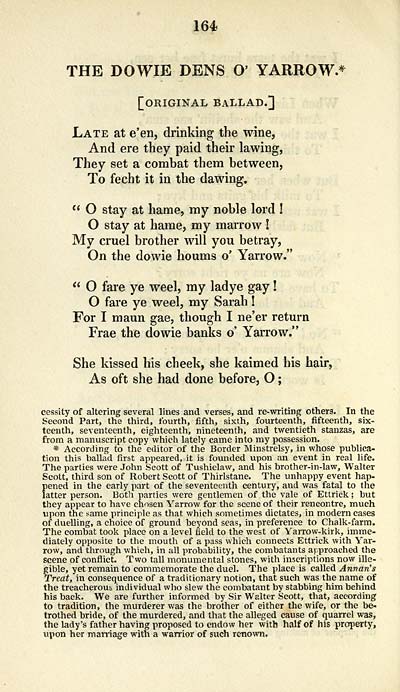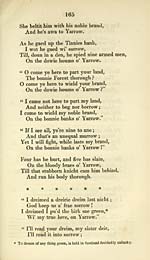Glen Collection of printed music > Printed text > Scottish ballads
(188) Page 164 - Dowie dens o' Yarrow
Download files
Complete book:
Individual page:
Thumbnail gallery: Grid view | List view

164
THE DOWIE DENS O' YARROW.*
[original ballad.]
Late at e'en, drinking the wine,
And ere they paid their lawing.
They set a combat them between.
To fecht it in the dawing.
" O stay at hame, my noble lord I
O stay at hame, my marrow I
My cruel brother will you betray,
On the dowie houms o' Yarrow."
" O fare ye weel, my ladye gay !
O fare ye weel, my Sarah I
For I maun gae, though I ne'er return
Frae the dowie banks o' Yarrow."
She kissed his cheek, she kaimed his hair,
As oft she had done before, O ;
cessity of altering several lines and verses, and re-writing others. In the
Second Part, the third, fourth, fifth, sixth, fourteenth, fifteenth, six-
teenth, seventeenth, eighteenth, nineteenth, and twentieth stanzas, are
from a manuscript copy which lately came into my possession.
* According to the editor of the Border Minstrelsy, in whose puhlica-
tion this ballad first appeared, it is founded upon an event in real life.
The parties were John Scott of Tushielaw, and his brother-in-law, Walter
Scott, third son of Robert Scott of Thirlstane. The unhappy event hap-
pened in the early part of the seventeenth century, and was fatal to the
latter person. Both parties were gentlemen of the vale of Ettrick ; but
they appear to have chosen Yarrow for the scene of their rencontre, much
upon the same principle as that which sometimes dictates, in modern cases
of duelling, a choice of ground beyond seas, in preference to Chalk-farm.
The combat took place on a level field to the west of Yarrow-kirk, imme-
diately opposite to the mouth of a pass which connects Ettrick with Yar-
row, and through which, in all probability, the combatants approached the
scene of conflict. Two tall monumental stones, with inscriptions now ille-
gible, yet remain to commemorate the duel. The place is called Annan's
Treat, in consequence of a traditionary notion, that such was the name of
the treacheroub individual who slew the combatant by stabbing him behind
his back. We are further informed by Sir Walter Scott, that, according^
to tradition, the murderer was the brother of either the wife, or the be-
trothed bride, of the murdered, and that the alleged cause of quarrel was,
the lady's father having proposed to endow her with half of his property,
upon her marriage with a warrior of such renown.
THE DOWIE DENS O' YARROW.*
[original ballad.]
Late at e'en, drinking the wine,
And ere they paid their lawing.
They set a combat them between.
To fecht it in the dawing.
" O stay at hame, my noble lord I
O stay at hame, my marrow I
My cruel brother will you betray,
On the dowie houms o' Yarrow."
" O fare ye weel, my ladye gay !
O fare ye weel, my Sarah I
For I maun gae, though I ne'er return
Frae the dowie banks o' Yarrow."
She kissed his cheek, she kaimed his hair,
As oft she had done before, O ;
cessity of altering several lines and verses, and re-writing others. In the
Second Part, the third, fourth, fifth, sixth, fourteenth, fifteenth, six-
teenth, seventeenth, eighteenth, nineteenth, and twentieth stanzas, are
from a manuscript copy which lately came into my possession.
* According to the editor of the Border Minstrelsy, in whose puhlica-
tion this ballad first appeared, it is founded upon an event in real life.
The parties were John Scott of Tushielaw, and his brother-in-law, Walter
Scott, third son of Robert Scott of Thirlstane. The unhappy event hap-
pened in the early part of the seventeenth century, and was fatal to the
latter person. Both parties were gentlemen of the vale of Ettrick ; but
they appear to have chosen Yarrow for the scene of their rencontre, much
upon the same principle as that which sometimes dictates, in modern cases
of duelling, a choice of ground beyond seas, in preference to Chalk-farm.
The combat took place on a level field to the west of Yarrow-kirk, imme-
diately opposite to the mouth of a pass which connects Ettrick with Yar-
row, and through which, in all probability, the combatants approached the
scene of conflict. Two tall monumental stones, with inscriptions now ille-
gible, yet remain to commemorate the duel. The place is called Annan's
Treat, in consequence of a traditionary notion, that such was the name of
the treacheroub individual who slew the combatant by stabbing him behind
his back. We are further informed by Sir Walter Scott, that, according^
to tradition, the murderer was the brother of either the wife, or the be-
trothed bride, of the murdered, and that the alleged cause of quarrel was,
the lady's father having proposed to endow her with half of his property,
upon her marriage with a warrior of such renown.
Set display mode to: Large image | Transcription
Images and transcriptions on this page, including medium image downloads, may be used under the Creative Commons Attribution 4.0 International Licence unless otherwise stated. ![]()
| Special collections of printed music > Glen Collection of printed music > Printed text > Scottish ballads > (188) Page 164 - Dowie dens o' Yarrow |
|---|
| Permanent URL | https://digital.nls.uk/87740230 |
|---|---|
| Description | Scottish songs and music of the 18th and early 19th centuries, including music for the Highland bagpipe. These are selected items from the collection of John Glen (1833 to 1904). Also includes a few manuscripts, some treatises, and other books on the subject. |
|---|
| Description | The Glen Collection and the Inglis Collection represent mainly 18th and 19th century Scottish music, including Scottish songs. The collections of Berlioz and Verdi collected by bibliographer Cecil Hopkinson contain contemporary and later editions of the works of the two composers Berlioz and Verdi. |
|---|

